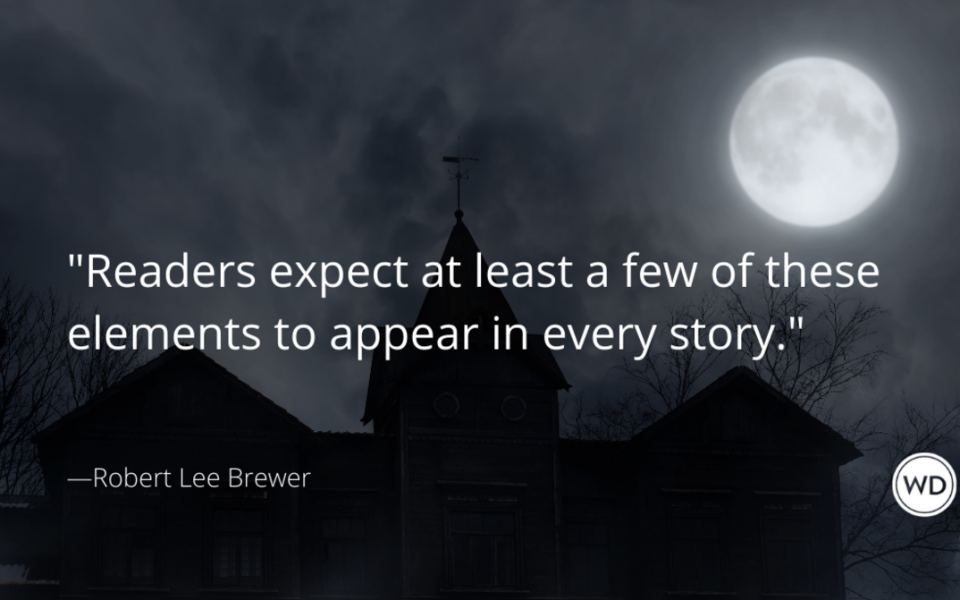21 Popular Horror Tropes for Writers
One fun thing about writing horror fiction is that the genre is loaded with several popular tropes that are acceptable for writers to use. In fact, readers expect at least a few of these elements to appear in every story.
(Playing With Common Horror Tropes for Comedic Effect.)
The main reason for this, I expect, is that tropes help set expectation and expectation (in horror anyway) starts building suspense. When are bad things going to happen? How will they happen? Who will make it through to the end? Will I be able to fall asleep tonight? (OK, that last one was a little personal.)
21 Popular Horror Tropes for Writers
Here are 21 examples of horror tropes for writers to consider and subvert when writing their spooky stories to send chills down the spines of their readers. And make it more difficult for people like myself to sleep at night and/or go see what that noise is outside my window.
- Summoning evil. A few kids find an old book that claims to summon a powerful spirit if you perform a certain ritual. What could go wrong?
- The abandoned place. It could be an old, spooky (maybe haunted) house, library, school, hospital, asylum, grocery store, prop shop, or cabin. The main thing is that it’s empty of everything but fear.
- Open windows and doors. Maybe because of horror movies, my windows and doors are always closed and locked. But horror stories always seem to make it easy for evil to enter.
- Nightmare that may have been real. Freddy Krueger built an entire franchise off this concept, but this trope can be dreamt in smaller doses as well.
- Death to the fornicators. Whether it’s teenagers getting it on or adults cheating on their spouses, having sex outside of wedlock is a big no-no in the world of horror…and usually signs the death certificate for the participants.
- Cursed artifact. It may be a toy, diary, VHS tape, jewelry, or something else that catches the eye of a character. Once they touch or take it, the curse begins.
- Finding old footage. The old footage may be video, audio, diary entries, tape cassettes, or an old website. It helps the characters understand more about the evil they’re potentially facing. And if the footage is a physical object, it may even double as the cursed artifact.
- Splitting up. Usually, this is done for the sake of expediency, but honestly, it just makes it that much easier for characters to get picked off.
- Secretive laboratory or base. Some kind of government or private testing facility that is up to who knows what. Well, that’s what is uncovered in your story.
- Inclement nighttime weather. Thick fog. Whiteout conditions. Dark and stormy night. The main thing is that it makes it hard to see what’s coming right at you.
- Alone in a dark house or building. It could be the abandoned place mentioned above, but it could also be their own house. Alone equals vulnerable in horror, regardless of the setting.
- Mysterious neighbor. The mysterious neighbor is usually new, but even a long-standing neighbor who keeps to themselves can have a lot of myths and conjectures made about them that may or may not be true.
- No trespassing. Characters are told what they’re not supposed to do (that is, ahem, not trespass), but they do it anyway. Release the kraken!
- Seeing things in mirrors. Or other reflective surfaces. I admit this is one that always freaks me out. (Of course, vampires don’t cast a reflection at all, which is also a little creepy.)
- Bad guy that won’t die. Even when you kill them in story after story in every conceivable way, they just keep coming back for more horror (and the money of hooked consumers).
- Feeling of being watched. Character feels (even knows) they’re being watched and maybe can even hear or catch little glimpses of things from their periphery, but they can’t confirm for sure that someone or something is there.
- Everywhere monsters. Yes, of course, vampires, werewolves, creatures from the deep and laboratories, 50-foot whatevers, and so on. But don’t forget that many of the regular people and characters in your stories should be monsters too.
- No communication. Splitting up can do this on a small scale, but there’s also the downed phone lines before cell towers and the dropped signals and zero bars since cell towers. This trope makes a character all alone, which is inherently scary.
- “I’ll be right back.” One of my favorite rules from the movie Scream. If you say you’ll be right back in horror, well, it was nice knowing you.
- Women and children last. This trope can be subverted, but it’s usually the case that the seemingly most vulnerable person is the one person most assured of making it to the end of the story, whether that’s a shy (and bookish) young woman or a quiet (and often orphaned) child.
- One last scare. Originally, I planned to make this a list of 20 horror tropes, but then I remembered one of the most popular tropes of all: One. Last. Scare. That one final scare or creepy twist that occurs after everything feels resolved.
Hope this list helps get you started. Feel encouraged to share your own favorites in the comments below.
*****
Learn from the experts on how to write a horror story that excites readers for decades (or centuries)! Even the scariest and most attention-grabbing horror story ideas will fall flat without a foundation of knowledge about the genre and expectations of the audience. In this collection, you’ll find practical tips for writing horror stories that are plausible and cliché-free.



